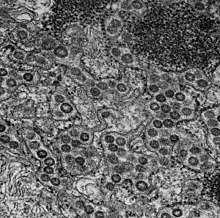MRC-5
MRC-5 ( Medical Research Council cell strain 5 , translated: " Medical Research Council, Cell Strain 5") is a diploid , human cell culture line . It consists of fibroblastic cells that originally came from the lungs of a 14-week-old male fetus . This was aborted in September 1966 by a 27-year-old, otherwise physically healthy mother because of psychological problems . The MRC-5 cells are incapable of causing tumors and have a low frequency of chromosomal abnormalities.
The cell line was isolated by JP Jacobs and colleagues after 7th cell division (PDL7). The cell line reaches senescence after about 45 to 60 divisions. Since the original supply runs out after around 40 years and the integrity and sterility of the original glass ampoules is at risk, the WHO has commissioned a second supply with a slightly increased doubling rate (PDL12).
application
MRC-5 cells have been used in recent years to produce several vaccines ( MMR - here rubella, chickenpox , hepatitis A and rabies ). In the early 1960s, Leonard Hayflick and Paul Moorhead discovered that viruses that are required for certain vaccinations develop better in human stem cells in the laboratory than in animal tissue or living animals. The latter had often been used before for production and cultivation, so z. B. previously used monkey kidney cells. With that production method from kidney tissue, however, it happened again and again that these also contained unwanted pathogens, while the cells originally obtained from the fetus enabled safe virus and thus vaccine production.
The cultivation on MRC-5 cells works in particular with rubella viruses , which are then contained in the rubella vaccine in a weakened form (for example with Priorix or Priorix-Tetra ). The viruses are cleaned for the vaccine and remnants of the cell culture are removed, but they may find their way into the vaccine as traces. According to PEI , these possible remnants of the cell line cultures are not ingredients, but auxiliary materials during production, since they are not “consciously added”.
Today, in addition to MRC-5, the WI-38 cell line, which is also derived from a fetus, is mainly used for the development of a large number of vaccines. In both cases, however, the fetuses were not aborted in order to extract tissue from them for the cell lines. In addition, these cell lines were removed from the fetuses once, after which they were continuously multiplied and frozen. It has been criticized in particular by religious communities that the MRC-5 cell line (and also WI-38) was obtained from an aborted fetus. However, the Catholic Church , but also other religious communities, see the production of such vaccines as justified in terms of their benefits. In 2003, the future Pope Benedict XVI. ( Joseph Ratzinger ) just praised the red chalk vaccine. In a 2017 statement, the Pontifical Academy for Life also advocated the use of such vaccines as justifiable.
See also
Web links
- Ralf Nowotny: Were cancer cells discovered in vaccines? (Fact check). In: mimikama . January 9, 2020, accessed on January 9, 2020 (German).
Individual evidence
- ↑ MRC-5 ATCC® CCL-171 ™ Homo sapiens lung Normal. American Type Culture Collection, accessed January 9, 2020 .
- ↑ AG05965-D. Coriell Institute for Medical Research, accessed January 9, 2020 .
- ↑ a b c d Ralf Nowotny: Were cancer cells discovered in vaccines? (Fact check). In: mimikama . January 9, 2020, accessed on January 9, 2020 (German).
- ↑ T. Betáková et al .: Overview of measles and mumps vaccine: origin, present, and future of vaccine production . In: Acta Virologica . tape 57 , no. 2 , 2013, p. 91-96 , doi : 10.4149 / av_2013_02_91 , PMID 23600866 .
- ^ A b Ross Hawkins and Miltiades Stylianou: SECOND REPLACEMENT SEED STOCK FOR MRC-5 CELLS. WHO, 2018, accessed March 4, 2020 .
- ↑ JP Jacobs et al .: Characteristics of a human diploid cell designated MRC-5 . In: Nature . tape 227 , no. 5254 , July 11, 1970, p. 168-170 , doi : 10.1038 / 227168a0 , PMID 4316953 .
- ↑ JP Jacobs: The status of human diploid cell strain MRC-5 as an approved substrate for the production of viral vaccines . In: Journal of Biological Standardization . tape 4 , no. 2 , January 1, 1976, p. 97-99 , doi : 10.1016 / 0092-1157 (76) 90018-4 .
- ↑ a b c Stanley A. Plotkin et al .: Plotkin's Vaccines . 7th edition. Elsevier, Philadelphia 2017, ISBN 978-0-323-35761-6 , pp. 1594 ( elsevier.com ).
- Jump up ↑ Vaccinations: How An Abortion Helped Save Millions of Lives. Der Spiegel , March 6, 2017, accessed on January 11, 2020 .
- ↑ Priorix specialist information. November 2019, accessed May 29, 2020 .
- ↑ technical information Priorix-Tetra. December 2019, accessed May 29, 2020 .
- ↑ a b c Joana Splieth: No, cells from human fetuses and monkeys or glyphosate are not ingredients of vaccinations. In: corrective . December 13, 2019, accessed on January 9, 2020 (German).
- ↑ Liz Neporent: What Aborted Fetuses Have to Do With Vaccines. In: ABC News . February 17, 2015, accessed January 10, 2020 .
- ^ Note on Italian vaccine issue. In: Pontifical Academy for Life. July 31, 2017, accessed May 1, 2020 .
